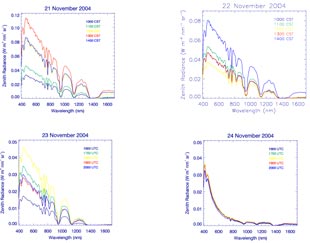
From November 19, 2004, to December 17, 2004, a new Shortwave Spectrometer (SWS) was deployed at the ARM Climate Research Facility Southern Great Plains (SGP) site as part of the engineering design process. The instrument, a modified version of the National Aeronautic and Space Administration’s airborne Solar Spectral Flux Radiometer, is configured in a zenith-viewing radiance mode with a 3° field-of-view. It is designed to collect measurements of wavelengths ranging from 350-1700nm, with a resolution of 8-12nm. These measurements will be used in a Quality Measurement Experiment to evaluate and improve models of shortwave spectral radiance. A similar evaluation was completed by ARM for longwave spectral radiance data from the Atmospheric Emitted Radiance Interferometer spectrometer.
Operating uninterrupted throughout the 29-day evaluation period, the SWS collected radiance spectra at a rate of 1 Hz. Approximately 36,000 spectra per day were obtained during daylight hours. To establish instrument offsets and noise levels, “dark signal”—the signal measured by the instrument when the optics are blocked and no light gets in—was obtained during business working days with the help of the SGP site personnel. All data were retrieved and monitored at NASA’s Ames Laboratory via a high-speed network connection. Comparisons between SWS and ARM’s Total Sky Imager qualitatively demonstrated good correlation between the measurements.
The late fall deployment provided a wide variety of weather conditions for operators to test the robustness of the SWS system. This month-long deployment will allow scientists and engineers to evaluate the proposed design and refine it, if necessary, prior to committing funds for the development/construction of the new instrument.

